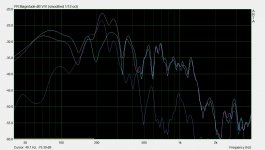Been a while since I've posted here, but this forum was always a source of inspiration and I thought I'd post my latest loudspeaker development here.
I'm listening to 3-way dipoles, bass is handled by Eminence Beta 15A in a (shallow) Y-Frame + T-Bass circuit (as developed by the late Graham Maynard here on diyaudio). An Y-Frame, like a U-Frame exhibit a quarter-wave resonance at tha back which needs to be dealt with, options are:
- damp it (as in NaO speakers)
- EQ
I've experimented with a third: placing a monopole (mid) woofer in the Y-Frame cavity that radiates in anti-phase. In my case, an 8" Monacor SPA-8PA in ~6L, which has the required sensitivity. Turned out it works rather well and you get some extra things for free:
- reduced back radiation at the respective resonance frequency, in my case ~250Hz. This happens to be a wavelength very close to the first reflection dip off the front wall, so it's very beneficial if you - like me - are forced to place dipoles relatively close to the wall
- no need for an extra amp channel (with a sensitive enough monopole driver). In order for it to work, the monopole should be subject to the same quarter-wave peak as the bass driver, that is, radiate into the cavity.
- subjectively, the midbass is punchier - in spite of the rather subtle effect at the front - compared to the plain dipole (both equalized flat)
Attached a measurement at the back. One can see the original response with the resonance, the bandpass output of the monopole "filler" and the end result. Surely can be done better, especially with an extra channel of DSP nd amp.
I'm listening to 3-way dipoles, bass is handled by Eminence Beta 15A in a (shallow) Y-Frame + T-Bass circuit (as developed by the late Graham Maynard here on diyaudio). An Y-Frame, like a U-Frame exhibit a quarter-wave resonance at tha back which needs to be dealt with, options are:
- damp it (as in NaO speakers)
- EQ
I've experimented with a third: placing a monopole (mid) woofer in the Y-Frame cavity that radiates in anti-phase. In my case, an 8" Monacor SPA-8PA in ~6L, which has the required sensitivity. Turned out it works rather well and you get some extra things for free:
- reduced back radiation at the respective resonance frequency, in my case ~250Hz. This happens to be a wavelength very close to the first reflection dip off the front wall, so it's very beneficial if you - like me - are forced to place dipoles relatively close to the wall
- no need for an extra amp channel (with a sensitive enough monopole driver). In order for it to work, the monopole should be subject to the same quarter-wave peak as the bass driver, that is, radiate into the cavity.
- subjectively, the midbass is punchier - in spite of the rather subtle effect at the front - compared to the plain dipole (both equalized flat)
Attached a measurement at the back. One can see the original response with the resonance, the bandpass output of the monopole "filler" and the end result. Surely can be done better, especially with an extra channel of DSP nd amp.
Attachments
Last edited:
It should be cardioid in a rather narrow range where the monopole meets the dipole-I'll try to do some polars these days. I think the Alien is cardioid all the way down to bass (judging by the size)
My focus was the resonance range and specifically wanted to keep it dipole below (and above) because I enjoy that bass very much. This allows the usage of a much smaller monopole driver and enclosure. Also, it can be switched off (but needs dsp adjustment)
My focus was the resonance range and specifically wanted to keep it dipole below (and above) because I enjoy that bass very much. This allows the usage of a much smaller monopole driver and enclosure. Also, it can be switched off (but needs dsp adjustment)
Have experimented with these for a while, but it turned out that the second bass source is kind of muddying the bass no matter what. It gives an on-axis peak on the front that is hard to control properly - no matter the EQ it just sounded worse than the dipole bass alone. Surely an additional DSP channel might help, but I'm not willing to introduce that much complexity in the system.
So I removed them. But while removing them I was looking at the pipe they were mounted in and I thought that maybe one can absorb some of the quarter-wave energy in the U-frame by means of a Helmholtz resonator. If you look at the pressure distribution in an open pipe as the graph on MJ King's site:
Quarter Wavelength Loudspeaker Design
there is a pressure maximum at the closed end, so I would put the opening of one or several (rather generous) Helmholtz resonators there.
Has anyone tried a similar idea ? I've seen it in bass enclosures of the Nordpole (http://www.fbruechert.de/daten/Nordpol-Bauplan.pdf)
So I removed them. But while removing them I was looking at the pipe they were mounted in and I thought that maybe one can absorb some of the quarter-wave energy in the U-frame by means of a Helmholtz resonator. If you look at the pressure distribution in an open pipe as the graph on MJ King's site:
Quarter Wavelength Loudspeaker Design
there is a pressure maximum at the closed end, so I would put the opening of one or several (rather generous) Helmholtz resonators there.
Has anyone tried a similar idea ? I've seen it in bass enclosures of the Nordpole (http://www.fbruechert.de/daten/Nordpol-Bauplan.pdf)
- Status
- Not open for further replies.
- Home
- Loudspeakers
- Multi-Way
- "Active" U-Frame quarter-wave cancellation

